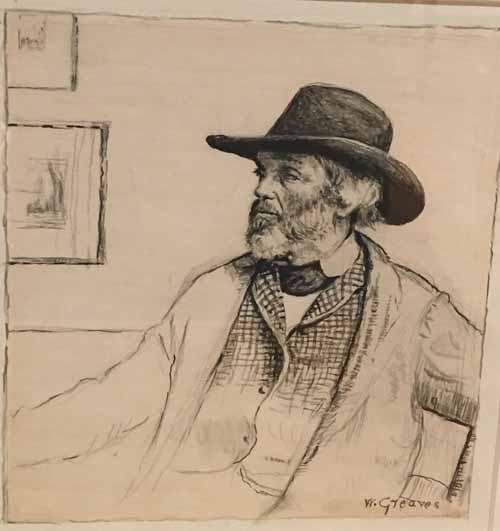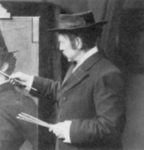

Walter Greaves
British, 1846-1930
Portrait of Thomas Carlyle, n.d.
pen and black in and wash over graphite on beige colored paper
Overall: 13 x 10 5/8 in.
SBMA, Bequest of Margaret Mallory
1998.50.34

Photo of Greaves painting a portrait of Whistler. Above right: a Greaves painting of Whistler painting his mother.

Finalized painting of Carlyle by Greaves. A giant of nineteenth-century thought, Thomas Carlyle was the son of a stone-mason and was born in Ecclefechan, Dumfriesshire. After graduating from Edinburgh University, he began to produce the articles, translations, essays and histories which were to make him world-famous. Carlyle and his gifted wife Jane lived in London, and their home in Cheyne Walk, Chelsea, became a place of pilgrimage for intellectuals from all over Europe. Greaves was a neighbour and made the studies for this portrait while Carlyle was sitting for James McNeil Whistler.
COMMENTS
English painter and etcher. His father was a Chelsea boat-builder who had been J. M. W. Turner's boatman. Greaves and one of his brothers, Henry Greaves (1844–1904), met Whistler in 1863, introducing him to the delights of the Thames, becoming his studio assistants, pupils and close friends for over twenty years. Such early works as Hammersmith Bridge on Boat-race Day (c. 1862; London, Tate) and Old Battersea Bridge (c. 1863; priv. col., see 1984 sale cat., no. 2) show Greaves as a master of primitive art, but his later nocturnes, drawings and etchings demonstrate his absorption of Whistler's teachings. Much of his work also provides a fascinating record of 19th-century Chelsea (e.g. Duke Street, Old Chelsea etching, ?1860–73; London, BM). During the late 1870s Whistler began to gather a more sophisticated group of friends, including Walter Sickert and Mortimer Menpes. Excluded from this circle, Greaves suffered years of neglect, misfortune and poverty before his discovery by William Marchant, proprietor of the Goupil Galleries, who exhibited Greaves's work in his London Gallery in 1911. Greaves's new-found glory was shortlived, however: three weeks after the exhibition opened, Whistler's self-appointed biographers, Joseph and Elizabeth Pennell, sullied his reputation by claiming that he had plagiarised Whistler's work. Despite the admiration of a few fellow painters Greaves again fell into obscurity and spent his last eight years as a Poor Brother of the Charterhouse.
Bibliography
E. R. Pennell and J. Pennell: The Life of James McNeill Whistler, 2 vols (Philadelphia and London, 1908, rev. 6/1920), vol. i, passim
E. R Pennell and J. Pennell, eds: The Whistler Journal (Philadelphia, 1921), pp. 114–45
R. R. Tatlock: ‘Walter Greaves', Burl. Mag., lviii (1931), pp. 261–2
Walter Greaves, 1846–1930 (exh. cat. by T. Pocock, London, Leighton House A.G. & Mus., 1967)
J. Ingamells: ‘Greaves and Whistler', Apollo, lxxxix (1969), pp. 224–5
T. Pocock: Chelsea Reach: The Brutal Friendship of Whistler and Walter Greaves (London, 1970)
Walter Greaves & the Goupil Gallery (sale cat., London, Parkin Gal., 1984)
- Michael Parkin, Grove Art Online, www.groveart.com
